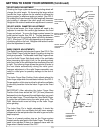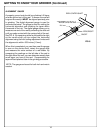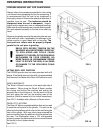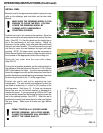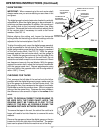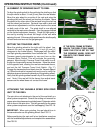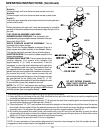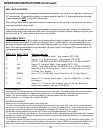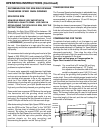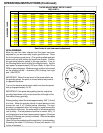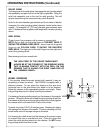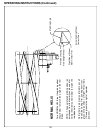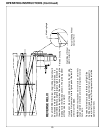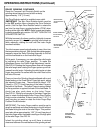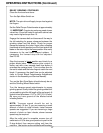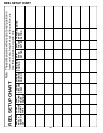
21
OPERATING INSTRUCTIONS (Continued)
COMPENSATING FOR TAPER.
To maintain the best quality of cut, the taper in a reel
must be removed returning the reel to a true cylinder.
To remove the taper that was measured with the gauge
(as discussed previously in Checking For Taper Section)
first align the reel to the shaft by the touch method (as
discussed previously). Then drop the side of the
grinding shaft that is high (the smaller side of the reel)
the amount suggested in the chart
[See chart on next page or Compensation for
Taper Chart located on the machine].
Example: For a reel that is 22 inches [56 cm] long
with a measured taper of .12" [3 mm],
the adjuster on the smaller side of the reel
would be dropped to read-.546 [13.9 mm].
This will bring the grinding shaft parallel to the reel
center shaft. Zero out the digital gauges located on the
vertical adjustment towers and infeed both side equally
until the wheel just touches the large side of the reel.
Zero the gauges again, you are now ready to grind and
remove the taper. When grinding, the wheel will only
make contact with the larger side of the reel and will
gradually grind more as the larger areas are ground
away. The reverse button may be used to help speed
of this process. Grind until full contact is made across
the entire length of the reel, and the reel is sharp the
entire width of all blades.
TRAVERSE DRIVE RPM
The Traverse Speed potentiometer is adjustable from
approximately 5 feet per minute [1.5 meters per minute]
to 20 feet per minute (6 meters per minute). It is
recommended to grind between 15 and 20 feet per
minute (4 and 6 meters per minute).
Grinding at a slower traverse speed, 10 feet per minute
(3 meters per minute) as an example, will give a better
finish but will extend the grind cycle time. Grind finish
versus grind cycle time is controlled by the choice of
the operator.
RECOMENDATION FOR SPIN DRIVE RPM AND
TRANSVERSE SPEED WHEN GRINDING
SPIN DRIVE RPM
SPIN DRIVE RPM IS VERY IMPORTANT IN
ACHIEVING A QUALITY GRIND. USE CARE IN
ESTABLISHING THE SPIN DRIVE RPM, PER THE
INSTRUCTIONS BELOW.
Generally, the Spin Drive RPM will be between 180
RPM (45%) and 380 RPM (100%). The speed required
to spin a specific reel is dependant on reel diameter,
the number of reel blades, and reel hardness. For all
reels, there is an optimum Spin Speed where there is
an AGGRESSIVE, yet smooth grind as you spin grind
the reel. Your objective is to spin grind the reel as
aggressively and as fast as possible while maintaining
top quality.
It is recommended to start grinding each reel at a Spin
Speed of 200 RPM (50%) and evaluate the RPM by
adjusting higher and lower to optimize the Spin Speed
for that reel. If the Spin Speed is incorrectly set, you
can experience two problems, grinding wheel
dressing or grinding wheel resonance. Each of these
problems is explained below.
On some reels, especially small diameter high blade
count reels if the Spin Speed RPM is set too high, the
reel can act as a dresser to the grinding wheel. There
can develop what appears to be a very aggressive
grind (as if the infeed has self infed) and then a
sudden stop of grinding with no grinding wheel to reel
contact. If this occurs, your Spin Speed was set too
high and you effectively dressed your grinding wheel.
Some reels have a resonant RPM where the reel goes
into harmonics with the grinding wheel and the
resonance vibrates the grinder and results in a very
bad grind. By changing the Spin Speed to a higher or
lower RPM you will move out of the resonant range.
After determining the best Spin Speed RPM for a reel,
note the RPM on the "Set-up Chart" in the "NOTES"
section. (Set-up chart is located at the back of this
manual) By noting the correct RPM, you will avoid
evaluating the Spin Speed the next time you grind the
reel. Also note the spin drive position using the
position decals on the spin mounting and
documenting the position on the "Set-up Chart".
AMOUNT
OF TAPER
IN SHAFT
AMOUNT OF
TAPER IN REEL



